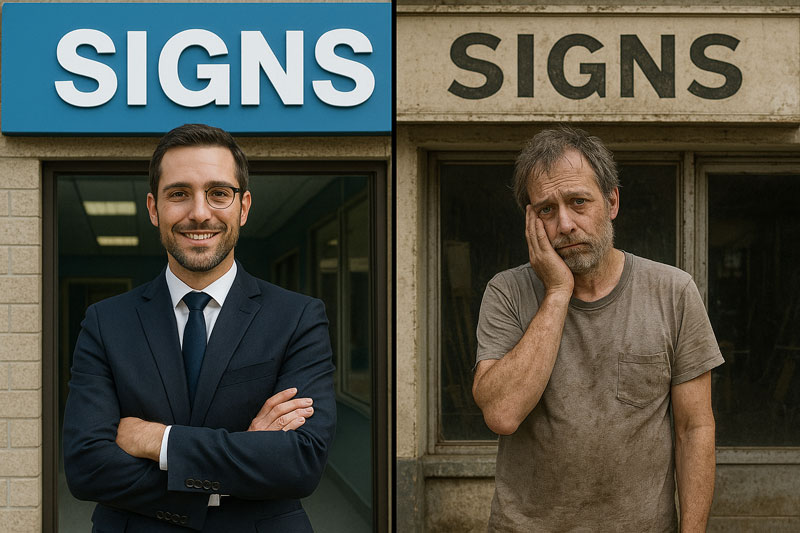The Leadership Divide: Why Ownership Defines Success
Across the U.S., there are thousands of signage companies operating in remarkably similar markets. They have access to the same materials, the same manufacturers, the same software, and the same customer base. Many even share vendors, pricing models, and marketing channels. Yet, despite these similarities, their results vary dramatically.
Some operate as lean, stagnant $2–3 million businesses, while others in the same cities grow to $15–20 million powerhouses with strong margins, consistent growth, and enviable reputations. What separates them isn’t luck, or even product — it’s ownership.
1. The Defining Factor: Ownership and Leadership
In the signage industry, ownership defines culture, and culture defines outcome. The companies that rise above the rest are almost always led by visionary, disciplined, and emotionally intelligent leaders — owners who don’t just work in their business but work on it.
These leaders:
-
Build teams that reflect their best traits, not their insecurities.
-
Hire people who are smarter than they are in key areas, then get out of their way.
-
Don’t tolerate toxicity — because they understand how corrosive it is to growth, morale, and customer experience.
-
See their company as a living system that must evolve, not just survive from job to job.
In contrast, struggling shops often share the opposite DNA. They’re led by owners who confuse tenure with leadership, or pride with performance. They hire in their own image — surrounding themselves with “yes” people instead of innovators — and keep underperformers because confrontation feels uncomfortable.
As a result, they plateau. Not because the market isn’t there, but because their leadership ceiling becomes the company’s ceiling.
2. The Visionary vs. The Operator
There’s a difference between operators and visionaries.
Operators keep the lights on. They manage quotes, production, and payroll. Visionaries, on the other hand, build systems that allow others to manage those things — freeing themselves to drive strategy, innovation, and relationships that create scale.
The signage companies that break the $10M mark usually make this transition early. They invest in technology (MIS/ERP platforms, CRM, production tracking), develop leadership layers, and replace “tribal knowledge” with process. Operators tend to resist this, believing their control is what keeps the company afloat — when in reality, it’s what keeps it small.
3. The Culture Multiplier
Culture is a multiplier — it amplifies everything.
In healthy companies, culture attracts talent, drives retention, and energizes growth. People want to perform because they feel trusted, aligned, and respected.
In struggling companies, culture becomes a slow poison. You’ll often hear phrases like:
“We’ve always done it this way,”
“That’s not my job,” or
“We can’t find good people.”
Those are leadership failures disguised as labor shortages.
The best owners lead with clarity, empathy, and accountability. They create structure without killing creativity. They reward initiative and make sure their team understands why their work matters — not just what they’re doing.
4. Technology and Adaptability
Visionary owners see technology as a growth enabler, not a necessary evil. They understand that integrated systems reduce redundancy, improve accuracy, and scale output without linear increases in cost.
They embrace platforms that give visibility across sales, production, and project management — not just to streamline, but to empower decision-making at every level.
Meanwhile, stagnant shops often cling to spreadsheets, siloed data, and “the way we’ve always done it.” They see technology as an expense instead of an investment, and that mindset costs them efficiency, insight, and eventually — relevance.
5. The Courage to Evolve
At the heart of it, the best signage companies are led by owners who are willing to evolve themselves.
They read, they listen, they benchmark, they learn. They attend trade shows not just to see new printers, but to meet new thinkers. They understand that success is not inherited — it’s reinvented, continuously.
The others? They protect the comfort zone that’s quietly killing them. They blame the economy, the market, or “kids these days,” never realizing that their company stopped growing when they did.
6. Closing Thought: The Mirror Test
Every signage company’s success story begins and ends with one truth — the company is the reflection of its owner.
If the owner is visionary, organized, and accountable, the company will be too.
If the owner avoids hard conversations, the company will rot from within.
If the owner is generous with credit and stingy with blame, the team will thrive.
And if the owner is willing to look in the mirror and ask, “What part of this company’s problems are mine to fix?” — that’s when transformation begins.

